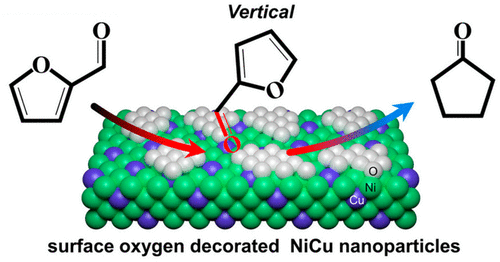当前位置:
X-MOL 学术
›
ACS Appl. Nano Mater.
›
论文详情
Our official English website, www.x-mol.net, welcomes your
feedback! (Note: you will need to create a separate account there.)
NiCu Nanoparticles for Catalytic Hydrogenation of Biomass-Derived Carbonyl Compounds
ACS Applied Nano Materials ( IF 5.3 ) Pub Date : 2020-09-01 , DOI: 10.1021/acsanm.0c01857 Mengran Liu 1, 2 , Liyuan Yuan 1 , Guoli Fan 1 , Lirong Zheng 3 , Lan Yang 1 , Feng Li 1
ACS Applied Nano Materials ( IF 5.3 ) Pub Date : 2020-09-01 , DOI: 10.1021/acsanm.0c01857 Mengran Liu 1, 2 , Liyuan Yuan 1 , Guoli Fan 1 , Lirong Zheng 3 , Lan Yang 1 , Feng Li 1
Affiliation

|
For heterogeneous supported catalysts, commonly, the adsorption of reactant molecules on the catalyst surface can significantly govern their activity and selectivity. In this paper, it was shown that surface oxygen-decorated bimetallic NiCu nanoparticles derived from ternary Ni–Cu–Al layered double hydroxide precursors exhibited better catalytic activity trends for the hydrogenolysis of biomass-derived carbonyl compounds compared with monometallic Ni or Cu ones. Specifically, bimetallic NiCu nanocatalyst achieved a maximum cyclopentanone yield of ∼89.5% in the aqueous phase hydrogenation of furfural. Based on a series of structural characterizations, catalytic experimental results, and density functional theory calculations, it was emphatically demonstrated that different catalytic behaviors might stem from the difference in the adsorption modes of the carbonyl group on the surfaces of monometallic Ni and bimetallic NiCu nanoparticles. It was deduced that due to the decoration of abundant surface oxygen species on bimetallic NiCu nanoparticles, the remaining exposed metal surface became η1(O)-type adsorption sites for the carbonyl group, different from the dominant η2(C, O) adsorption mode on monometallic Ni nanoparticles with less surface oxygen species. Most importantly, the present bimetallic NiCu nanoparticles as catalysts displayed superior catalytic performance in the hydrogenolysis of other carbonyl compounds (e.g., 5-hydroxymethylfurfural, benzaldehyde, and vanillin) to monometallic ones. Such surface oxygen decoration strategy endows bimetallic NiCu nanoparticles a great application potential in the catalytic conversions of biomass-derived carbonyl compounds.
中文翻译:

NiCu纳米粒子催化生物质衍生的羰基化合物的加氢反应
对于非均相负载型催化剂,通常,反应物分子在催化剂表面上的吸附可显着控制其活性和选择性。在本文中,研究表明,与单金属Ni或Cu相比,由三元Ni-Cu-Al层状双氢氧化物前体衍生的表面装饰有氧的双金属NiCu纳米粒表现出更好的催化活性,用于生物质衍生的羰基化合物的氢解。具体而言,双金属NiCu纳米催化剂在糠醛的水相加氢中获得的最大环戊酮产率为〜89.5%。根据一系列结构特征,催化实验结果和密度泛函理论计算,有力地证明了不同的催化行为可能源于单金属Ni和双金属NiCu纳米颗粒表面上羰基的吸附方式的不同。可以推断,由于在双金属NiCu纳米颗粒上装饰了丰富的表面氧,剩余的暴露金属表面变为η1(O)型的吸附位点的羰基,从主导η不同2(C,O)吸附于单金属纳米粒子的Ni具有较少表面氧种模式。最重要的是,本发明的双金属NiCu纳米颗粒作为催化剂在将其他羰基化合物(例如5-羟甲基糠醛,苯甲醛和香兰素)氢解为单金属化合物中表现出优异的催化性能。这种表面氧修饰策略赋予双金属NiCu纳米颗粒在生物质衍生的羰基化合物催化转化中的巨大应用潜力。
更新日期:2020-09-25
中文翻译:

NiCu纳米粒子催化生物质衍生的羰基化合物的加氢反应
对于非均相负载型催化剂,通常,反应物分子在催化剂表面上的吸附可显着控制其活性和选择性。在本文中,研究表明,与单金属Ni或Cu相比,由三元Ni-Cu-Al层状双氢氧化物前体衍生的表面装饰有氧的双金属NiCu纳米粒表现出更好的催化活性,用于生物质衍生的羰基化合物的氢解。具体而言,双金属NiCu纳米催化剂在糠醛的水相加氢中获得的最大环戊酮产率为〜89.5%。根据一系列结构特征,催化实验结果和密度泛函理论计算,有力地证明了不同的催化行为可能源于单金属Ni和双金属NiCu纳米颗粒表面上羰基的吸附方式的不同。可以推断,由于在双金属NiCu纳米颗粒上装饰了丰富的表面氧,剩余的暴露金属表面变为η1(O)型的吸附位点的羰基,从主导η不同2(C,O)吸附于单金属纳米粒子的Ni具有较少表面氧种模式。最重要的是,本发明的双金属NiCu纳米颗粒作为催化剂在将其他羰基化合物(例如5-羟甲基糠醛,苯甲醛和香兰素)氢解为单金属化合物中表现出优异的催化性能。这种表面氧修饰策略赋予双金属NiCu纳米颗粒在生物质衍生的羰基化合物催化转化中的巨大应用潜力。











































 京公网安备 11010802027423号
京公网安备 11010802027423号